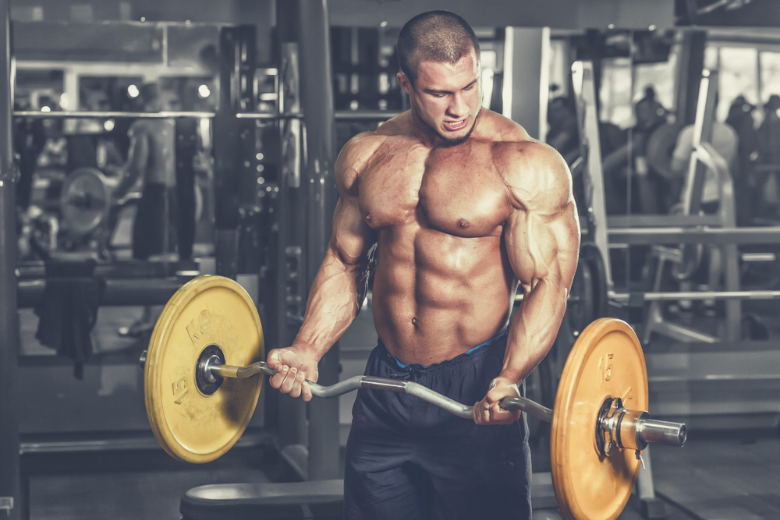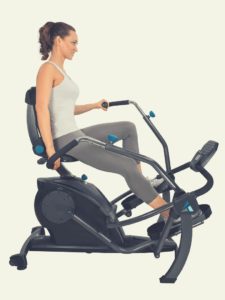If you are in a hurry and just want to find out what the best books on strength training for beginners are, and among them, we recommend Frederic Delavier’s Strength Training Anatomy as the best one.
Let us be real for a moment and acknowledge that there are a ton of strength training books out there.
How are beginners supposed to decipher all the sales pitches and fitness claims to choose the best book to get them started?
Well, we have reviewed five of the best books on strength training for beginners on the market.
Here are the top books on strength training for beginners that we’ll be reviewing:
- Strength Training Anatomy
- Starting Strength: Basic Barbell Training
- Essentials of Strength Training and Conditioning
- Bigger Leaner Stronger: The Simple Science of Building the Ultimate Male Body
- The Strength Training Anatomy Workout

Getting Started
Choosing a book to get you started on your fitness journey can be tricky.
You do not want a book that is going to overwhelm you, but you also do not want a book that is going to underwhelm you.
We’ve compiled a list of some things that may be useful to keep in mind as you are evaluating our reviews of the best books on strength training.
How to Choose the Best Strength Training Book For You
Start by being honest with yourself.
I have injured myself countless times by jumping into a training regimen that was higher than my level at that time, and I lost loads of time because of it.
If I would have just started at the level I was truly at, then I would have ended up saving time and frustration in the long run.
Take a moment to level with yourself before you start your fitness journey so that you can make the most of your efforts and not have an easily-avoided injury get in the way.
An injury only keeps your training goals further away.
With training goals in mind, you also want to make sure that you are choosing one of the best books on strength training that meets your needs.
If you are looking to workout strictly at home with minimal equipment, then there is no point buying a book that focuses on heavy strength training that requires a rack and barbell which you likely would not have at home.
The same can be said if you already have some foundational knowledge and you are looking at beginners’ books on using gym equipment.
If this is your goal and you are just looking to begin a gym routine, then buying a strictly at-home workout book probably is not going to get you to the next level.
Getting to the next level is the purpose of buying a strength training book in the first place.
Whether you are trying to begin or advance in your journey, it is important that you take your physical and mental headspace around the goal into consideration.
Start at a level that is comfortable for you, not with where everyone else is or where you think you should be.
Do You Even Need a Strength Training Book?
Simply put, yes, you do need a strength training book.
Even if you are planning to spend money on a highly-qualified personal trainer, there is still something to be said for doing some self-study.
A personal trainer will cover a lot in a single session. It is good to have something to refer to for those times when you are working out on your own.
You aren’t going to be able to remember everything.
Having one of the best books on strength training will be a great supplement to personal training sessions.
It will likely keep you more engaged and make your paid sessions more fruitful.
For those of you who are not going the personal trainer route, it is even more important for you have a book to refer to.
With a book, you will be able to clearly structure your workouts to get the most out of your time, and you will get great direction on form so that you do not get injured.
Plus, you will be more confident and excited going into your workouts because you will know that you are invested both physically and mentally.
At the end of the day, having a book far outweighs just winging it at the gym.

Precautions to Consider Before Starting Any New Fitness Routine
While, yes, many books will provide you with basic knowledge on how to approach strength training safely, there are still some things you may want to take precaution with.
By far the most obvious is considering your prior injuries.
Do a mental scan of your body while noting prior injuries and take this into account as you train.
If you injured your shoulder a decade ago and it has not hurt you for years, it is still important to strengthen all the muscles before adding serious weight.
Start slow.
Reviews of the Best Books on Strength Training
We have carefully reviewed each of these books and listed out some important pros and cons that should help you get off to a great start in choosing one that meets your needs.
Strength Training Anatomy
Strength Training Anatomy is authored by Frederic Delavier and the third edition is what is being reviewed.
Pros
- The author keeps the text short and relies on over 600 expertly drawn illustrations of the human body performing weight training movements. Therefore, you will have a visual to connect with his direction.
- There are seven sections of the book divided by body part. You will have a section for arms, shoulders, chest, back, legs, glutes and abdomen.
- Great for any experience level. This book will teach you not only what muscles are being used, but also proper form to engage those muscles with each weight lifting exercise defined by the author.
- This book will help you visualize the mind-muscle connection that will help you keep muscles working for longer periods of time, so your gains will be maximized.
- You will not only find the how-to for each exercise, but you will also find the how-to-not for each exercise. This ensures your ability to visualize both scenarios before hitting the gym.
- Both men’s and women’s strength training anatomy are shown and briefly explained.
- You will find detailed information about not only the muscle function but also how the muscles, bones and tendons work together in each movement.
Cons
- The book does not have specific training plans, only instruction on how to properly execute strength training movements.
Starting Strength: Basic Barbell Training
Starting Strength: Basic Barbell Training is authored by Mark Rippetoe and illustrated by Jason Kelly. The third edition is being reviewed.
Pros
- There is an app called Starting Strength that complements the information in the book, and it is a great resource for those just beginning an exercise routine.
- This book takes a deep-dive into compound lifts, which are a critical component of any training routine and a highly effective way to lift. You will complete the book with the knowledge and confidence to get strong in a safe and consistent manner.
- The diagrams used in this book are excellent, they do a great job of helping you visualize the movements.
- The book also lays out a specific program for you to start with, so you will not have to figure out how to apply all this great knowledge you just learned by yourself.
Cons
- This book only covers compound lifts that require a rack and barbell, so your exercises may be limited at the gym if this is the only book you rely on.
- Some of the movement break-downs can get quite long-winded, so this may not be the book for you if don’t want to take a deep-dive into the reading material.
Essentials of Strength Training and Conditioning
The fourth edition of Essentials of Strength Training and Conditioning is what is being reviewed.
Pros
- This book takes a deep-dive into the science behind strength training, so it is an excellent option if you are looking for more than just an explanation on form accompanied primarily by visuals.
- This book was written by the National Strength and Conditioning Association (NCSA), so you know the information is credible and scientifically backed.
- The book is an excellent study guide for the nationally recognized Certified Strength and Conditioning (CSCS) exam.
- Two practice exams are included in Essentials of Strength Training and Conditioning for the CSCS, so you do not have to buy another book to get test experience.
Cons
- This book is incredibly dense because it is meant to be used as a study guide to pass the CSCS exam, so it is not the best book to buy just to flip through to gain basic concepts.
- If you are looking for scientific information on the general athlete population, then this book is great. However, this book lacks important information if you are looking to learn to train individuals with disabilities of any sort.
- The illustrations in this book are not anatomical. Instead, they are full-colored images that do not break down the muscle function.
Bigger Leaner Stronger: The Simple Science of Building the Ultimate Male Body
Bigger Leaner Stronger: The Simple Science of Building the Ultimate Male Body is authored by Michael Matthews.
Pros
- If you are looking for nutritional plans in addition to a new fitness routine, then this book is a great option.
- This book is a viable option for those stuck in a plateau or having taken some time off from strength training and need some motivational words to get going again.
- A large focus of this book is how to enjoy exercise and the general mindset behind making strength training a lifestyle rather than just a phase.
Cons
- This book focuses only on male strength training. Therefore, female readers will need to opt for a different book.
- The information in this book presents somewhat as an infomercial, so it can be difficult to stay engaged because you will feel like you are trying to be sold something even though you already bought the book.
- This book is not for beginners as it expects you to already have the foundational knowledge of how-two form-related questions for each exercise.
The Strength Training Anatomy Workout
The Strength Training Anatomy Workout is co-authored by Frederic Delavier and Michael Gundill.
Pros
- This is a great book for beginners because it starts slow and takes the time to teach you the absolute fundamentals before you dive into anything more strenuous. Therefore, you will begin your weight-lifting journey with the proper knowledge to progress safely.
- Like all Delavier’s books, the anatomical illustrations are top-notch and help to point out what you should be focusing on during each strength training movement.
- You will find structured workout routines that are easy to follow and are targeted at various results, so you can follow the one that most closely meets your goals.
- Not only will you find how to do things the right way, but the author also puts a bug into your ear as to what you may be feeling when you are doing lifts with compromising form.
- As the title suggests, this book encompasses minimal workout equipment such as resistance bands, dumbbells and a chair.
Cons
- This book is not going to be super helpful for gym-goers who already have a foundation of strength straining. It focuses on light workouts with minimal equipment that you can do at home.
- This book underestimates women’s ability to lift heavy weight respective to their size.
What Book do we Think is Best?
We chose Frederic Delavier’s Strength Training Anatomy book as the winner because it has rich content that is easily absorbed.
It is the most comprehensive book that gives you enough information to get to the next level no matter where you are starting.
It does not focus on one exercise, one stage or specific pieces of equipment. Plus, it shows you the inner workings of the bone, muscle and tendon.
Knowing what you are working during each movement rather than just how the movement is done will be a huge benefit to your training.
This is a book you can learn from at any stage in life for many years to come.










